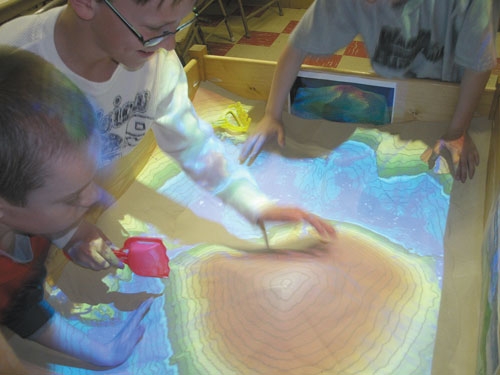You are here
Home ›St. Patrick School incorporating Augmented Reality Sandbox into science and other curriculum

St. Patrick School in Waukon recently purchased a new Augmented Reality Sandbox with a three-dimensional camera and projector that is being incorporated into the school's science and other curriculum. Pictured above, St. Patrick students manipulate the sand to make different landforms that are then contoured by the camera and projector in real time on the overlay display. Submitted photo.
by Brianne Eilers
The St. Patrick Elementary School in Waukon is beginning to incorporate an innovative new learning tool into its curriculum, the Augmented Reality (AR) Sandbox. As the name suggests, this piece of equipment is a sand box with a three-dimensional (3-D) camera that reads the contours of the sand in the box, creating and displaying an overlay on the sand surface that is essentially a topographical map (see photo accompanying this article). The different elevations are represented in contour lines and different colors.
The AR sandbox was developed at the University of California-Davis. St. Patrick's has had its AR Sandbox for about one month, but students have been taking any opportunity they can to use it. "It's a very interactive tool," said St. Patrick computer and music instructor Tim Lund.
In addition to showing elevation, the sandbox can be virtually flooded with water to illustrate how water flows and can be used to teach students about flooding and flood plains. Third grade students at St. Patrick's learn about land forms in science, and this is one hands-on, supplemental tool that teachers can use to show students more about land forms.
It is also used to teach sixth grade students about watershed areas and conservation. Lund noted that the software can be altered with a few lines of code to create a lava overlay instead of water, to also illustrate how lava and volcanoes work.
The equipment itself includes a sandbox that was constructed by St. Patrick custodian Bryce Koenig, a computer, and the projector. Students may use their hands or other tools to move the sand in the sandbox around, to change the landscape contours and elevations. The camera and projector work in real time, so students can see the changes on the overlay in seconds. Students can also make it virtually rain to show how water flows are affected by certain types of land forms.
Lund noted that the students are very interested in learning to use this equipment, and he has even had students inquire if they can use their recess time to use the AR sandbox. Schools are trying to find more ways to incorporate technology into the learning process, and St. Patrick's is no different. In addition to this new piece of equipment, Lund noted that sixth grade students will be joining the 1-to-1 Initiative with netbooks provided for each student in the next school year.

